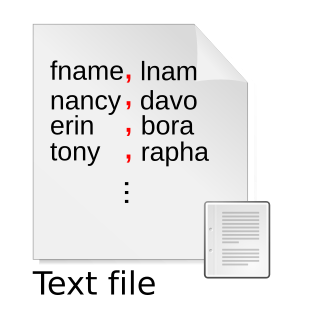Related Research Articles

In computing, plain text is a loose term for data that represent only characters of readable material but not its graphical representation nor other objects. It may also include a limited number of "whitespace" characters that affect simple arrangement of text, such as spaces, line breaks, or tabulation characters. Plain text is different from formatted text, where style information is included; from structured text, where structural parts of the document such as paragraphs, sections, and the like are identified; and from binary files in which some portions must be interpreted as binary objects.

Extensible Markup Language (XML) is a markup language and file format for storing, transmitting, and reconstructing arbitrary data. It defines a set of rules for encoding documents in a format that is both human-readable and machine-readable. The World Wide Web Consortium's XML 1.0 Specification of 1998 and several other related specifications—all of them free open standards—define XML.
In computing and telecommunication, an escape character is a character that invokes an alternative interpretation on the following characters in a character sequence. An escape character is a particular case of metacharacters. Generally, the judgement of whether something is an escape character or not depends on the context.
In computing, the Java API for XML Processing, or JAXP, one of the Java XML Application programming interfaces, provides the capability of validating and parsing XML documents. It has three basic parsing interfaces:
In computer science, an escape sequence is a combination of characters that has a meaning other than the literal characters contained therein; it is marked by one or more preceding characters.
A string literal or anonymous string is a literal for a string value in the source code of a computer program. Modern programming languages commonly use a quoted sequence of characters, formally "bracketed delimiters", as in x = "foo", where "foo" is a string literal with value foo. Methods such as escape sequences can be used to avoid the problem of delimiter collision and allow the delimiters to be embedded in a string. There are many alternate notations for specifying string literals especially in complicated cases. The exact notation depends on the programming language in question. Nevertheless, there are general guidelines that most modern programming languages follow.
In computer programming, Base64 is a group of binary-to-text encoding schemes that transforms binary data into a sequence of printable characters, limited to a set of 64 unique characters. More specifically, the source binary data is taken 6 bits at a time, then this group of 6 bits is mapped to one of 64 unique characters.

A JAR file is a package file format typically used to aggregate many Java class files and associated metadata and resources into one file for distribution.
YAML(see § History and name) is a human-readable data serialization language. It is commonly used for configuration files and in applications where data is being stored or transmitted. YAML targets many of the same communications applications as Extensible Markup Language (XML) but has a minimal syntax that intentionally differs from Standard Generalized Markup Language (SGML). It uses Python-style indentation to indicate nesting and does not require quotes around most string values.

Comma-separated values (CSV) is a text file format that uses commas to separate values, and newlines to separate records. A CSV file stores tabular data in plain text, where each line of the file typically represents one data record. Each record consists of the same number of fields, and these are separated by commas in the CSV file. If the field delimiter itself may appear within a field, fields can be surrounded with quotation marks.

A delimiter is a sequence of one or more characters for specifying the boundary between separate, independent regions in plain text, mathematical expressions or other data streams. An example of a delimiter is the comma character, which acts as a field delimiter in a sequence of comma-separated values. Another example of a delimiter is the time gap used to separate letters and words in the transmission of Morse code.
In computer science, canonicalization is a process for converting data that has more than one possible representation into a "standard", "normal", or canonical form. This can be done to compare different representations for equivalence, to count the number of distinct data structures, to improve the efficiency of various algorithms by eliminating repeated calculations, or to make it possible to impose a meaningful sorting order.
The data URI scheme is a uniform resource identifier (URI) scheme that provides a way to include data in-line in Web pages as if they were external resources. It is a form of file literal or here document. This technique allows normally separate elements such as images and style sheets to be fetched in a single Hypertext Transfer Protocol (HTTP) request, which may be more efficient than multiple HTTP requests, and used by several browser extensions to package images as well as other multimedia content in a single HTML file for page saving. As of 2024, data URIs are fully supported by all major browsers.

JSON is an open standard file format and data interchange format that uses human-readable text to store and transmit data objects consisting of attribute–value pairs and arrays. It is a commonly used data format with diverse uses in electronic data interchange, including that of web applications with servers.
An INI file is a configuration file for computer software that consists of a text-based content with a structure and syntax comprising key–value pairs for properties, and sections that organize the properties. The name of these configuration files comes from the filename extension INI, for initialization, used in the MS-DOS operating system which popularized this method of software configuration. The format has become an informal standard in many contexts of configuration, but many applications on other operating systems use different file name extensions, such as conf and cfg.

In computer programming, a comment is a programmer-readable explanation or annotation in the source code of a computer program. They are added with the purpose of making the source code easier for humans to understand, and are generally ignored by compilers and interpreters. The syntax of comments in various programming languages varies considerably.
XPath is an expression language designed to support the query or transformation of XML documents. It was defined by the World Wide Web Consortium (W3C) in 1999, and can be used to compute values from the content of an XML document. Support for XPath exists in applications that support XML, such as web browsers, and many programming languages.
Apache Click is a page and component oriented web application framework for the Java language and is built on top of the Java Servlet API.
Escape sequences are used in the programming languages C and C++, and their design was copied in many other languages such as Java, PHP, C#, etc. An escape sequence is a sequence of characters that does not represent itself when used inside a character or string literal, but is translated into another character or a sequence of characters that may be difficult or impossible to represent directly.
Fielded Text is a proposed standard which provides structure and schema definition to text files which contain tables of values. The standard allows the format and structure of the data within the text file to be specified by a Meta file. This Meta file can then be used to access the data in the file in manner similar to which data is accessed in a database.
References
- ↑ Translate Toolkit's po2prop converts native character encodings in a Gettext PO file into correctly escaped ascii without the need for native2ascii
- ↑ Java XML Properties DTD
- ↑ "java - How to use UTF-8 in resource properties with ResourceBundle". Stack Overflow . Archived from the original on 2015-03-17. Retrieved 2015-01-28.
- ↑ "Internationalization Enhancements in JDK 9". Oracle Help Center. Retrieved 2018-01-05.
- ↑ "JEP 226: UTF-8 Property Resource Bundles". OpenJDK. Retrieved 2020-09-03.
- ↑ "IResourceBundle". Adobe ActionScript 3 (AS3 Flex) API Reference.
- ↑ "uriworkermap.properties configuration". The Apache Tomcat Connectors - Reference Guide.
- ↑ "Config::Properties - Read and write property files". metacpan.org.
- ↑ "SAPUI5 SDK - Demo Kit". sapui5.hana.ondemand.com. Retrieved 2019-05-14.
- ↑ "keywords:properties java parse - npm search". www.npmjs.com. Retrieved 2022-03-22.
- ↑ "Packagist". packagist.org. Retrieved 2022-03-22.